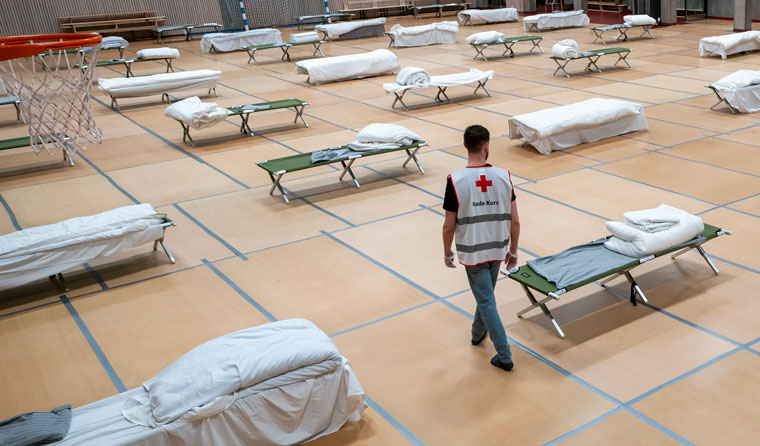News
Calls to separate coronavirus patients to slash infection rates
In-hospital spread of the coronavirus is a real threat, doctors in Italy have warned. How is Australia preparing?
 Nations like Norway are setting up field hospitals to cope with surges of serious COVID-19 cases.
Nations like Norway are setting up field hospitals to cope with surges of serious COVID-19 cases.
State governments in Australia are scrambling to find alternatives to hospitals ahead of an expected surge of coronavirus cases, amid calls to separate COVID-19 patients from others to reduce spread within the health system.
Victoria is reportedly looking to convert the Melbourne Convention and Exhibition Centre into a coronavirus treatment facility, while Tasmania will use hotel rooms for isolation and a larger accommodation facility for treatment.
Queensland is assessing whether an unfinished hospital can be used, South Australia is bringing two recently decommissioned hospitals back online, while a NSW Health spokesperson told newsGP the state is planning to expand hospital capacity and use private accommodation if necessary.
These will operate parallel to the slowly growing number of respiratory clinics, which are designed to test for coronavirus.
Nations around the world are rapidly moving to build field hospitals or repurpose other large venues as coronavirus treatment facilities, with the UK converting a large convention centre into a 4000-bed facility.
RACGP President Dr Harry Nespolon told newsGP that GPs could potentially offer healthcare if governments move away from hospitals to treat coronavirus patients.
‘If the government is going to use places other than hospitals such as hotels to treat patients when the hospitals are full, the patients will still need medical care,’ he said.
‘This could be offered by either hospital medical staff or GPs depending on the clinical need of the patients.’
The move comes as doctors in the worst hit areas of Italy have called on the world to find ways of decentralising care wherever possible in order to reduce the danger of hospitals becoming vectors of spread.
‘[W]e are learning that hospitals might be the main COVID-19 carriers, as they are rapidly populated by infected patients, facilitating transmission to uninfected patients,’ the doctors write in an NEJM Catalyst article.
They call for the rapid creation of home care and mobile clinics to relieve pressure on hospitals and reduce unnecessary patient movement, as well as home delivery of oxygen therapy and pulse oximeters for the mildly ill or recovering patients.
‘This approach would limit hospitalization to a focused target of disease severity, thereby decreasing contagion, protecting patients and health care workers, and minimizing consumption of protective equipment,’ they write.
The calls demonstrate the danger of further spread if health systems become overwhelmed, as they have in northern Italy.
In-hospital spread was a major challenge in the two earlier coronavirus outbreaks that caused SARS and MERS, as patients in these outbreaks became more infectious as the disease worsened and they required hospitalisation.
By contrast, the new CoV-2 virus is less lethal in terms of case fatality rate, but more adept at spreading in both community and healthcare settings, with people able to pass the infection while asymptomatic, mildly unwell or critically ill.
A Journal of the American Medical Association study on the early trajectory of the virus in Wuhan, China, found around two-fifths of patients most likely acquired the infection while in hospital.
In better news, US surgeon and author Atul Gawande has pointed out in a New Yorker article on protection of healthcare workers that Singapore and Hong Kong have proven it is possible to effectively contain the coronavirus in healthcare settings without having to go the full-body hazmat-style approach seen in Wuhan.
Like Australia, Singapore and Hong Kong had shortages of essential personal protective equipment (PPE). To deal with the issue, both relied on separating possible coronavirus patients from any other patients in dedicated respiratory clinics, with separate medical teams.
The Italian doctors make a similar point – that separation of coronavirus patients from others is essential.
But Mr Gawande notes that ordinary surgical masks, gloves and hand hygiene, combined with strict disinfection regimens and social distancing, proved effective, while both Singapore and Hong Kong restricted the use of scarce N95 masks, face-protectors, goggles, and gowns were reserved for aerosol-generating procedures such as intubation.
‘Transmission seems to occur primarily through sustained exposure in the absence of basic protection or through the lack of hand hygiene after contact with secretions,’ he writes.
That is backed by a recent Annals of Internal Medicine case report on an incident in Singapore where 42 healthcare workers were potentially exposed to the virus during the intubation of a patient.
None of the healthcare workers contracted the virus – 85% of them were wearing surgical masks and 15% were using an N95 mask.
‘That none of the healthcare workers in this situation acquired infection suggests that surgical masks, hand hygiene, and other standard procedures protected them from being infected,’ the authors write.
‘Our observation is consistent with previous studies that have been unable to show that N95 masks were superior to surgical masks for preventing influenza infection in healthcare workers.’
National security expert Associate Professor Alexey Muraviev states in The Conversation that Australia’s defence forces should be on standby in case field hospitals and emergency supplies are required.
Log in below to join the conversation.
coronavirus hospitals public health
newsGP weekly poll
As a GP, do you use any resources or visit a healthcare professional to support your own mental health and wellbeing?